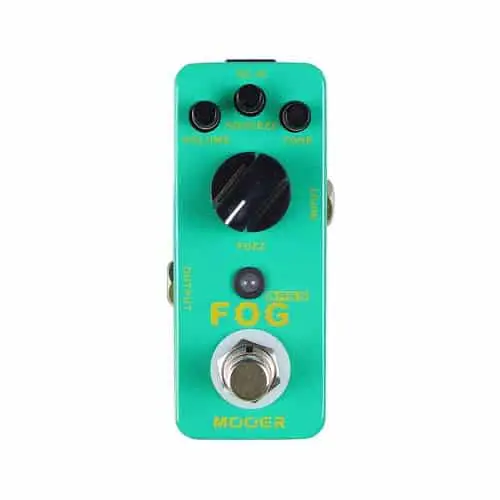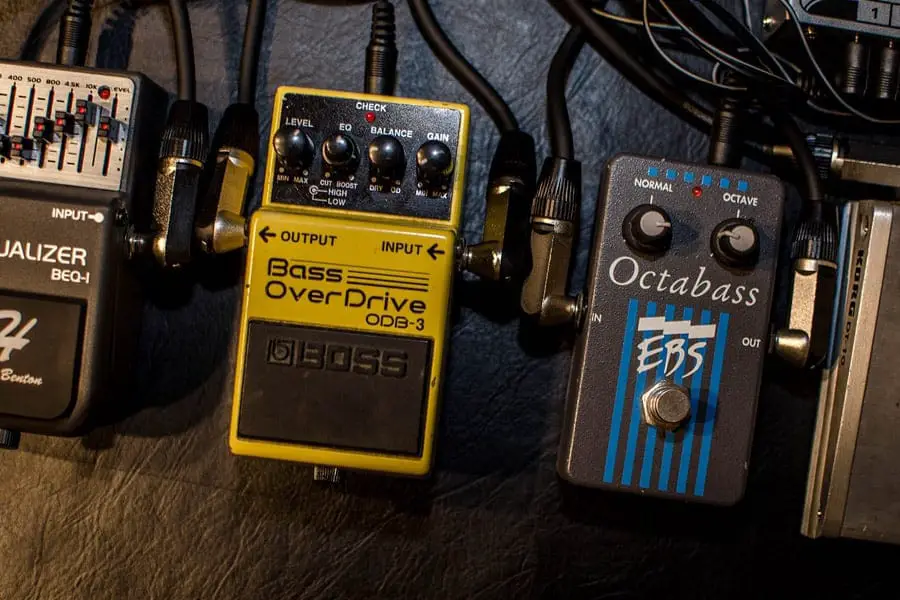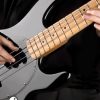In this article, we’re going to be discussing what the best bass distortion pedals are, that exist in 2021.
However, before we talk about each product featuring within the list, we wanted to briefly talk about what exactly a bass distortion processor unit is, and why you may want to get one for your guitar rig.
Well, let’s get started!
What is a Bass Distortion Pedal?
A Distortion Pedal is an effects unit that manipulates and alters the waveform and sound of an inputted signal.
It was originally used by guitarists in the 1960s who turned up the gain on their tube amplifiers to achieve an overdriven distortion.
Many describe this effect as adding a growling, gritty or fuzzy tone to an instrument’s signal.
Bass Distortion is more commonly used in rock and indie music, with bands like Muse, Metalica and The Who most famously using the effect.
For more information on Bass Distortion, take a look at Wiki.
A Bass Distortion Pedal is more commonly used in both live performance environments and studio settings.
An important point to bring up, due to the way in which this kind of pedal distorts and saturates a signal, it’s best to be strategic about where it is placed within your pedal board’s signal chain.
Therefore it should be placed in a spot within the chain where the noise floor is not likely to be accentuated by pedals further down the signal path.
If you happen to also be interested, take a read of our article on the best bass overdrive pedals.
As always, we’ve arranged the list based on price, from least expensive (at the top), to the most expensive processor (at the bottom).
Alongside this, we’ve talked about each product’s features, technical specifications and have also included a video demonstration, so that you can find the ideal pedal for you!
Therefore, without further ado, let’s talk about the 5 best bass distortion processors of 2020.
Best Bass Distortion Pedals
Kokko Bass Distortion Processor

Features
- Small, metal distortion pedal with anti-skid rubber pads
- Two-stage distortion performance
- Inexpensive to purchase
- True Bypass
- Runs on a 9V battery, but can also be directly run on a 9v power supply (not included)
Technical Specifications
- 1 x 1/4″ jack input
- 1 x 1/4″ jack output
- 9v battery (included): 9v AC adaptor is sold separately (9V Power Supply – Buy on Amazon)
- Weight: 0.3lbs
- Dimensions : 4.1″ x 2.6″ x 2.4″ inches
For a demonstration of the processor, take a look at the video demonstration below:
Summary
The Kokko mini distortion pedal is an extremely inexpensive unit.
With 3 main knobs for Tone, Level, and Gain, it’s very simple to use, ideal for the gigging musician who wants a nice little distortion pedal, whilst not having to care if it gets beaten up, because hey, it only cost you $23.99.
This the pedal is primarily used for guitar distortion, but we think that it would be the perfect distortion pedal for bass… since it’s cheap and delivers a rather nice quality distortion effect.
Just make sure you play around with the EQ settings pre & post distortion, as you may find this pedal knocks out your low-end frequencies, hence a low-end EQ boost after this in the signal chain may be beneficial…
Moorer MFZ4 Fog Distortion Pedal For Bass

Features
- A unique boutique pedal
- Created specifically for Bass Guitar
- A strong metal shell casing
- Ultra-unique sounding vintage fuzz & distortion tones
- True Bypass
Technical Specifications
- 1 x 1/4″ jack input
- 1 x 1/4″ jack output
- 9v battery (included): 9v AC adaptor is sold separately (9V Power Supply – Buy on Amazon)
- Weight: 1.0lbs
- Dimensions : 1.6″ x 4.2″ x 2.2″ inches
For a demonstration of the processor, take a look at the video demonstration below:
Summary
The MFZ4 Fog distortion pedal by Moorer is certainly an interesting piece of hardware!
I mean you only have to take a listen to the video demonstration below to realize how utterly unique and quirky this processor sounds…
It’s exciting just to hear the potential.
The unit has four knobs to help mold your sound, these include volume, squeeze, tone, and fuzz.
And you’ll have fun playing around with these settings to create that ultimate fuzz-sounding distortion.
This pedal is ideal for using in-studio and live on-stage, with it being small enough (and strong enough) to fit on your pedal-board with no issues.
This processor is fairly inexpensive at around $50 and is certainly for the bass player who prefers boutique-ESC bass pedals that not every bassist owns.
We can near guarantee that other bassists will be asking how you get that ‘cool vintage fuzz bass tone’ after using this!
MXR M85 Bass Distortion Pedal

Features
- Built specifically for Bass Guitar
- Engineering by MXR Electronics, Jim Dunlop & Fuzzrocious founder (Ryan Ratajski)
- Integrates unique circuitry, based on a classic ‘nasty sounding’ bass distortion which has been modified.
- Bright LED for visual confirmation that the Processor’s engaged
- A number of interface controls
- Dry: Adjusts the amount of Dry Signal
- Wet: Adjusts the amount of Wet Signal
- Tone: Adjusts the tonality of the distortion
- LED: Select LED diodes to change clipping character
- SIL: Select Silicon diodes to change clipping character
- Dist: Adjust the level of distortion applied
- Runs on a 9V battery, but can also be directly run on a 9v power supply (not included)
- Link to Owners Manual
Technical Specifications
- 1/4″ jack input
- 1/4″ jack output
- 9v battery (included): 9v AC adaptor is sold separately (9V Power Supply – Buy on Amazon)
- Weight : 0.85lbs
- Dimensions : 5.5″ x 2.5″ x 4.4″ inches
For a demonstration of the processor, take a look at the video demonstration below:
Summary
The MXR M85 by Jim Dunlop is certainly a small pedal that packs a punch!
Its metal chassis is small enough to fit onto your pedalboard without reserving much space, which means that it’s very useful for the gigging musician who wants a well-designed and rugged pedal.
When it comes down to the sound quality, it really does provide a high-quality distortion, that’s for sure (take a listen to the video demonstration below), and that’s because of the uniquely modified circuitry within the unit, which is based on a classic distortion circuitry.
Alongside the high-quality internal components, it features a range of user interface controls including wet & dry signal controls, distortion intensity, and tonality, alongside LED/Silicon diode engagement.
We’re confident in saying that you’ll be happy with the distortion sound quality that this pedal provides, I mean just take a look at the reviews (Amazon Reviews of MXR M85).
Whether or not you need this device for live performances or studio recording, it’s got your back! Overall, a fantastic bass distortion pedal.
If we had any criticism of this interface (if we’re being ultra picky), it’s the fact that you cannot save presets like you can with a digital distortion pedal.
However, you are unlikely to be able to get this kind of sound quality with a digital pedal.
Source Audio One Series Aftershock Bass Distortion Pedal

Features
- Distortion pedal designed specifically for Bass
- Bright lit LED when the pedal is engaged
- High-quality bass distortion sounds
- Highly versatile, yet very easy to use
- USB connectivity to …. for more in-depth parameter control
- Ability to use Neuro Desktop Editor & Mobile App to tweak pedal sounds
- 3 main overdrive functions (Tube – smooth, Heavy and Fuzz)
- Range of interface controls
- Drive:
- Level:
- Clean: Adjust the level of dry (natural signal) heard within the mix
- Tone: Adjust the tonality of the distortion
- Overdrive Type:
- Tube: Emulates a smooth, vintage overdriven tube amplifier
- Heavy: Aggressive scooped sounds with highs and deep lows
- Fuzz: Plenty of fizz, bottom-end, and grit
- Stereo input/output pedal design
- Dual drive engines and stereo inputs/outputs
- True Bypass
- Remote control using Source Audio expression pedal
Technical Specifications
- 2 x 1/4″ jack input
- 2 x 1/4″ jack output
- 9v battery (included): 9v AC adaptor is sold separately (9V Power Supply – Buy on Amazon)
- Weight: 1.1lbs
- Dimensions : 10″ x 6.0″ x 3.0″ inches
For a demonstration of the processor, take a look at the video demonstration below:
Summary
The Aftershock by Source Audio is a diamond in the rough.
Now at Sustain Punch, we hadn’t heard of Source Audio before stumbling upon this particular pedal, and might I say, after hearing this thing in action, it really is a contender to other more well-known branded distortion pedals.
Firstly, you might need a pen and paper, because the sheer amount of functionality that this pedal offers, is truly mind-blowing.
Don’t be fooled by the minimalistic interface.
This the processor is housed in a lightweight, durable aluminum chassis and provides stereo input/output.
The real power behind the Aftershock bass pedal and attribute that sets it apart from other pedals is the Neuro-Control options.
This pedal can plug into your computer (Mac/PC) via USB connectivity, or can connect to your IOS/Android device, and then can be personalized, with a huge array of advanced & additional control parameters and effects for you to incorporate.
The Neuro software can also be used to provide 12 different kinds of distortion, overdrive, and fuzz, which can be easily assigned to one of the three toggle switch settings.
When this pedal is used in conjunction with the Source Audio ‘Neuro Hub‘, it’s then fully MIDI controllable, and then 128 presets can be saved, for instant recall in the studio, or live on-stage.
The pedal can also connect to an expression pedal for expressive control of any parameter.
The pedal easily allows you to blend the distorted signal and dry signal, through using the ‘Clean’ and ‘Drive’ rotary knobs, which is very useful, as some low-end EQ may be lost as distortion is added, so being able to blend the original signal into the overall output signal is particularly useful.
The only gripe about this interface is that it doesn’t allow for quick and easy switching between the 3 distortion parameters, especially if you’re looking at using this on a live performance, and have to switch between distortion types during a song…
I.E you would need to reach down and manually change the toggle.
Otherwise, you will need to purchase the Source Audio Hub, which enables you to then use any brand of MIDI foot controller, to easily switch between presets.
Electro-Harmonix Deluxe Bass Big Muff Pi

Features
- Bass Distortion unit by Electro-Harmonix
- Designed & Built in the USA
- Strong Die-Cast Metal Chassis for increased durability
- The Deluxe Bass Big Muff has a wide range of interface functions for users to play around with
- Volume: Output volume for the pedal, capable of boosting input by 14dB
- Blend: control for the ability to mix dry and wet signal easily
- Tone: Adjusts the tone of the distortion effect, anywhere from adding high treble to deep bass.
- Sustain: Adjusts the amount of sustain on the distortion effect
- Gate: Controls noise-gate signal threshold
- Crossover: Crossover Circuitry to help sculpt the overall sound
- HPF: When a crossover is engaged, adjust the cut-off frequency of the High-Pass Filter (125hz – 1.75khz)
- LPF: When a crossover is engaged, Adjust the cut-off frequency of the Low-Pass Filter (60 Hz – 10 kHz)
- Input Switch: Toggle to engage 10dB of attenuation on the input signal
- Runs on a 9V battery, but can also be directly run on a 9v power supply (not included)
- Link to Owners Manual
Technical Specifications
- 1/4″ jack input
- 1/4″ jack output (effect), 1/4″ jack output (dry)
- 1 XLR DI output
- 9v battery (included): 9v AC adaptor is sold separately (9V Power Supply – Buy on Amazon)
- Weight : 1.6lbs
- Dimensions : 7.2″ x 3.2″ x 6.2″ inches
For a demonstration of the processor, take a look at the video demonstration below:
Summary
The Deluxe Bass Big Muff Pi by Electro-Harmonix truly is an incredibly versatile effects unit.
The processor is the Deluxe version and has certain features that the normal version doesn’t have, including the following functions: ‘Blend’, ‘Crossover’, ‘Gate’, ‘High-Pass Filter’, ‘Low-Pass Filter’, ‘Input Toggle’ and XLR DI output.
Because of these features, the Deluxe Bass Big Muff Pi can achieve an immense range of bass distortion and filter effects that the ‘normal’ processor cannot.
Overall, we’re really impressed with this unit, it’s perfect for the gigging musician who wants a strong unit, which is highly versatile and sounds great…
Also, the XLR DI output makes it perfect for a bassist who wants to send the signal straight to the FOH desk, for PA amplification.
In Conclusion, what’s the best distortion pedal for bass?
Ok, so similarly with all of our equipment reviews, instead of recommending one product for every reader, we like to segment our recommendations based on a number of factors, including technical features, sound quality, price, use-case, and your budget.
Hence, we’ve laid out the recommendations below:
Premium price, high-quality distortion pedal with plenty of sounds: We honestly cannot choose between the MXR M85, Electro-Harmonix Big Muff Pi and the Source Audio Aftershock, as they are all fantastic processing units which will deliver a beautiful bass tone…
Whichever sounds best to your ears, you’ve made a good choice.
Vintage-sounding, boutique-look distortion pedal: Mooer MFZ4 Fog Bass Distortion.
Well, we hope that you’ve enjoyed reading our review of the best bass distortion pedals, if you have any feedback or content requests then please contact us via our contact page.



